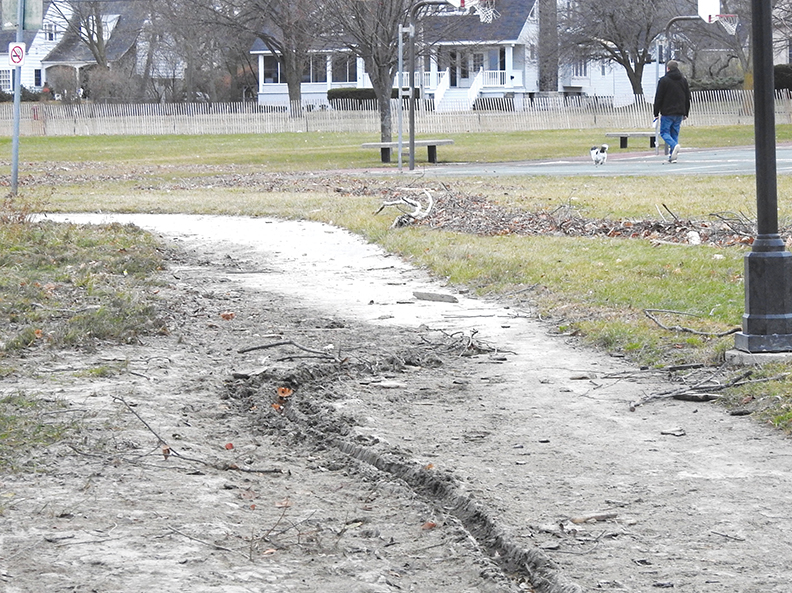High water recedes … a little

News Photo by Julie Riddle A walker skirts the mud-covered bike path in Bay View Park in Alpena on Tuesday.
ALPENA — Lowering water marks on a rigged-up gauge at the Rogers City marina give rise to cautious optimism, according to Harbormaster Wayne Saile.
The gauge — which, at its peak this summer, showed a water level 53 inches above where it ought to be — indicates that Lake Huron waters have now receded by at least a foot, Saile said.
The lowering levels are a natural seasonal change, and water is still higher than its 100-year average, according to Lauren Fry, physical scientist with the National Oceanic and Atmospheric Administration.
After high water wreaked havoc, causing tens of thousands of dollars in damage since spring and summer 2019, lower water is better than nothing, Saile said, but it’s too soon to know whether shoreline parks and properties are in the clear from potential water and ice damage during the winter ahead.
“It needs to get down another foot before we can go, ‘Whoo! That was close,'” Saile said.

News Photo by Julie Riddle Debris strews a bike path at Bay View Park in Alpena on Tuesday.
Fed by what Fry called the wettest five years on record in the Great Lakes basin, water levels in the upper Great Lakes have risen dramatically since 2013. Last fall, high levels combined with storm surges took out parks, piers, and shoreline structures from Rogers City to Harrisville.
So far, this fall hasn’t been bad, Saile said, although damaging storm surges could still be ahead.
He’s aware of lakefront homeowners who have had to keep their sump pumps running nonstop and whose yards washed away from the high water that continued this summer.
Though levels in Lakes Michigan and Huron — measured as one lake because they connect in the Straits of Mackinac — remained high all summer, they never hit the historic high point recorded in October 1986. Levels in 2020 were actually a little below those of 2019, Fry reported.
In Alpena, higher-than-usual water is still wreaking havoc, according to Harbormaster Don Gilmet.

News Photo by Julie Riddle Seagulls make use of broken railings on the Blair Street Pier in Alpena.
He regularly gets complaints from residents asking why a pier wasn’t fixed or why the city can’t keep the shoreline clean of mud and debris left by sloshing water and wind.
“We’ve tried,” Gilmet said. “But, the bottom line is we’re just spending thousands of dollars to clean things up that, in five hours, could be right back the way they were.”
The bike path in Bay View Park is half-covered in mud and rock, with driftwood and other remnants of surging water strewn far beyond the limestone boulders intended to serve as a shoreline.
In summer, especially when guests were expected in town, the city tried to keep the paths clear and parks looking good. As weather gets worse, though, regular cleanup doesn’t make financial sense, Gilmet said.
When the Blair Street pier was damaged by ice last winter, planners decided it wouldn’t be responsible to repair it, knowing water levels were still high enough to cause further damage.

News Photo by Julie Riddle Smitka Park in Rogers City shows evidence of high-water damage caused in October 2019.
The pier has held up against Up North winters and waters since the late 1980s, but, after its significant damage, planners will need to redesign it in spring to make sure it withstands ice and water levels like those seen in recent years, Gilmet said.
It’s impossible to predict what kind of ice pack to expect on the Great Lakes this winter, according to Deanna Apps, physical scientist with the U.S. Army Corps of Engineers.
Forecasts suggest Lake Superior will have a colder winter than normal, but it’s a toss-up for Lake Michigan-Huron, and the amount of ice on the lakes — and the potential damage it could cause — remains to be seen, Apps said.
For now, Gilmet said, Alpena needs to be cautious about how much it spends on cleanup and repairs to make sure that, come spring, it has enough money to put up its share to be able to qualify for grants Gilmet hopes to receive to help the shoreline recover.
City leaders are meeting next week to discuss ways to make the harbor and shoreline stronger and more sustainable.
“Everybody is very concerned about everything along the waterfront,” Gilmet said. “It’s why people want to live here.”
- News Photo by Julie Riddle A walker skirts the mud-covered bike path in Bay View Park in Alpena on Tuesday.
- News Photo by Julie Riddle Debris strews a bike path at Bay View Park in Alpena on Tuesday.
- News Photo by Julie Riddle Seagulls make use of broken railings on the Blair Street Pier in Alpena.
- News Photo by Julie Riddle Smitka Park in Rogers City shows evidence of high-water damage caused in October 2019.









